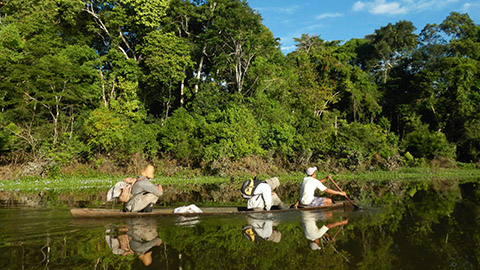Amazonian Fern Identification Now Possible Online
The Amazon Research Team of the University of Turku has launched an online tool that makes it possible for both beginners and specialists to identify Amazonian ferns. The tool makes it easier to collect data on rain forests for conservation planning.

Amazonian plants are still poorly known, so researchers collect specimens of all the species encountered in the field. This makes it possible to verify species identifications afterwards by comparing the material with specimens present in different herbaria. In the photo above, Gabriela Zuquim and Kalle Ruokolainen are pressing the plant catch of the day between newspapers.
Researchers from the Amazon Team of the University of Turku have shown that ferns can be used to identify different forest types in Amazonia. Thanks to their long field expeditions, the researchers know the Amazonian species exceptionally well. Now, they have created an online tool that makes it possible for others to identify Amazonian ferns as well. The tool is an interactive key freely available to anyone with an internet connection.
– We have been studying the ecology of Amazonian rain forests for a long time, and have found that ferns can provide important information for conservation planning and other applications, explains Dr. Hanna Tuomisto, the responsible leader of the project.
Until now, only fern specialists have been able to identify fern species, because no identification key has been available for Amazonia.
– The purpose of our online tool is to change this. We hope it inspires people to collect more data on Amazonian plants. This would increase the general understanding of the rain forest ecosystem which is still very poorly known, says Dr. Tuomisto.
– We have tried to make the tool as easy to use as possible. Everything is illustrated, so the user can simply compare a fern specimen with the pictures. The tool contains more than 5,000 photos and drawings. Since it is online, we can update it whenever we want, and the additions and corrections will be immediately available to the users, says Dr. Gabriela Zuquim, who did most of the tool development.
– This is a multi-entry key. It has many questions about the plant, and you can answer any of them in any order. If a question seems difficult, you can skip it and answer an easier one, adds Dr. Jefferson Prado from the Botanical Institute of São Paulo.
Authors of the tool have recently described three new species of the fern genus Metaxya, and the tool already contains these.
– Species are found in Amazonia and described as new to science all the time. At the moment, our key includes about 250 species, but more will be added in the future. We had to leave out many species for now because either they have no species name yet, or it is not known which name is correct, Dr. Tuomisto explains.
The online tool is an international collaborative effort with authors from Finland, Brazil and Peru. The tool has also been tested and improved in workshops in USA, Peru and Brazil. The project was funded by the Academy of Finland.

Canoes can reach small rivers and lakes that are unavailable for ships. In the photo above, researchers are going to a field work site using a canoe borrowed from the locals.
JV / SY
Photos: Hanna Tuomisto